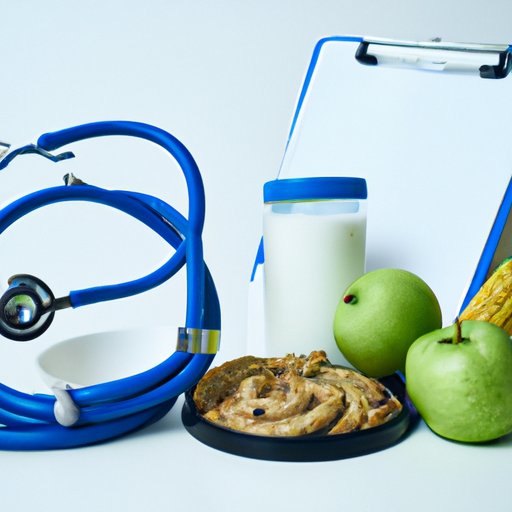
Exploring the Diet Restrictions After a Colonoscopy
A colonoscopy is a medical procedure used to examine the inner lining of the large intestine and rectum. It is an important screening tool for colorectal cancer, and it can also be used to diagnose and treat other digestive problems. After a colonoscopy, it is important to follow the doctor’s instructions for recovery, including any special dietary restrictions. Knowing what to eat and what to avoid after a colonoscopy can help promote a safe and successful recovery.
What to Avoid After a Colonoscopy
In general, it is best to avoid solid foods for the first day or two after a colonoscopy. Solid foods can cause abdominal pain and cramping due to the air that is introduced during the procedure. Drinking clear liquids, such as water, tea, and broth, is recommended until the bowel function returns to normal. Other foods to avoid after a colonoscopy include:
- Alcohol
- Caffeinated beverages
- Raw fruits and vegetables
- Dairy products
- High-fiber foods
- Spicy foods
- Processed meats
Why Diet Restrictions Are Important
The body needs time to heal after a colonoscopy. Eating certain types of foods can interfere with the healing process and can cause discomfort. For example, alcohol and caffeine can irritate the lining of the intestines and delay healing. High-fiber foods and processed meats can be difficult to digest and can cause abdominal pain. Eating raw fruits and vegetables can also cause abdominal pain because they can increase gas in the intestines. Following the doctor’s instructions for a diet after a colonoscopy can help reduce the risk of complications.

What to Eat After a Colonoscopy
Once the body has had enough time to rest and recover, it is important to reintroduce healthy foods back into the diet. Foods that can be reintroduced immediately after a colonoscopy include:
- Cooked fruits and vegetables
- Lean proteins, such as chicken and fish
- Whole grains, such as brown rice and oatmeal
- Healthy fats, such as olive oil and avocados
- Low-fat dairy products
How to Reintroduce Foods After a Colonoscopy
It is important to reintroduce foods slowly and gradually after a colonoscopy. Start with small portions of easy-to-digest foods and gradually increase the portion size and variety over the course of several days. If the body does not tolerate a particular food, stop eating it and try another one. It is also important to drink plenty of fluids to stay hydrated and to help flush out any residual medication from the body.

Nutritional Tips to Follow After a Colonoscopy
Eating a nutritious diet is essential for promoting optimal health and well-being. After a colonoscopy, it is important to focus on eating foods that are rich in vitamins and minerals. This includes eating a variety of fruits and vegetables, lean proteins, whole grains, and healthy fats. Additionally, it is important to stay hydrated by drinking plenty of water throughout the day. Fiber intake should also be increased to help keep the bowels regular.
Benefits of Eating Right After a Colonoscopy
There are many benefits to eating right after a colonoscopy. Eating a nutritious diet can help promote a speedy and successful recovery. In addition, eating a balanced diet can help reduce the risk of complications, such as abdominal pain, diarrhea, constipation, and nausea. Eating right can also provide the body with the essential vitamins and minerals it needs to stay healthy and strong.
How to Avoid Complications After a Colonoscopy
Complications after a colonoscopy are uncommon, but they can occur if the patient does not follow the doctor’s instructions for recovery. Abdominal pain is the most common complication, and it can be caused by eating too much or too soon after the procedure. Diarrhea or constipation can also occur if the patient does not drink enough fluids or does not eat enough fiber. Finally, nausea may occur if the patient eats too much or eats the wrong foods.

An Overview of Foods to Eat After a Colonoscopy
Eating a balanced diet is the best way to ensure a successful recovery after a colonoscopy. Fruits and vegetables are an excellent source of vitamins and minerals, and they are easy to digest. Lean proteins, such as chicken and fish, can help build and repair muscle tissue. Whole grains, such as brown rice and oatmeal, provide energy and fiber. Healthy fats, such as olive oil and avocados, can help the body absorb nutrients.
Conclusion
Following a colonoscopy, it is important to adhere to the doctor’s instructions for a diet. Avoiding solid foods, alcohol, caffeine, and high-fiber foods for the first day or two can help promote a safe and successful recovery. Once the body has had enough time to rest and recover, it is important to reintroduce healthy foods back into the diet. Eating a balanced diet that includes plenty of fruits and vegetables, lean proteins, whole grains, and healthy fats can help reduce the risk of complications and promote optimal health and well-being.
(Note: Is this article not meeting your expectations? Do you have knowledge or insights to share? Unlock new opportunities and expand your reach by joining our authors team. Click Registration to join us and share your expertise with our readers.)
